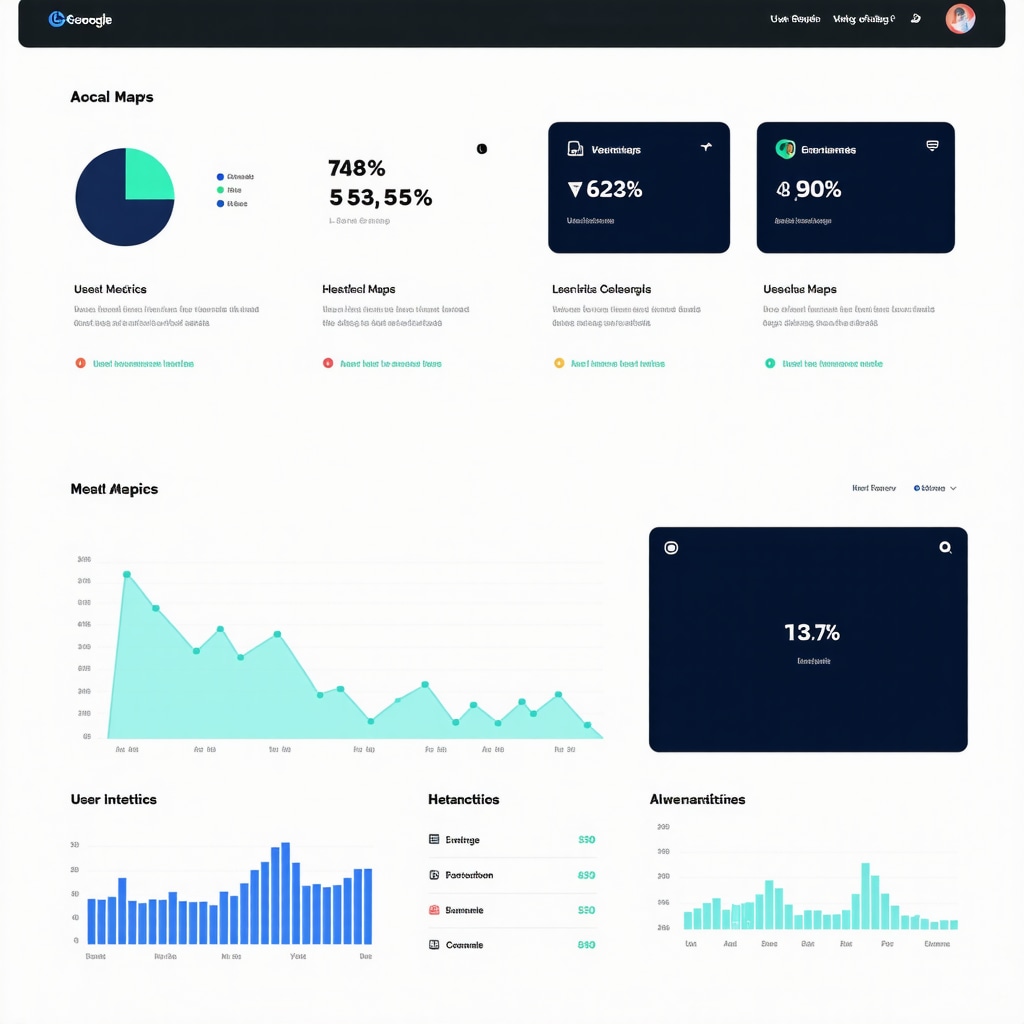Unlocking Local Success: Why Google My Business SEO Matters for Small Businesses
In the fiercely competitive realm of local search, Google My Business (GMB) has emerged as the cornerstone for small businesses eager to attract nearby customers. Mastering GMB SEO isn’t just about ticking boxes; it’s about strategically harnessing a powerful platform to enhance visibility, credibility, and ultimately, revenue. This guide dives deep into expert techniques that small businesses can implement to climb local rankings and capture attention in their communities.
Crafting a Magnetic Profile: The Art and Science of GMB Optimization
A perfectly optimized GMB profile acts like a beacon for local customers. Start by ensuring every detail—business name, address, phone number (NAP)—is meticulously accurate and consistent with your website and citations. Incorporate relevant local keywords naturally into your business description and services to speak the language your customers use when searching. For instance, a bakery in Brooklyn should emphasize terms like "Brooklyn artisan bread" or "local Brooklyn pastries." This semantic relevance signals Google that your business is a prime local match.
How Can Small Businesses Leverage GMB Features to Maximize Local Engagement?
Beyond basic info, fully utilize GMB’s rich features: post regular updates about promotions or events, add high-quality photos showcasing your products or premises, and list your services with clear descriptions. Engaging with customer reviews by responding promptly not only boosts trust but also influences ranking factors. For example, a local café that replies thoughtfully to reviews often sees increased foot traffic and online inquiry rates. Moreover, adding Q&A entries addressing common customer queries provides valuable content that enhances your profile’s authority.
Harnessing Local Citations and Backlinks: Building a Web of Trust and Authority
Local citations—mentions of your business on reputable directories and websites—serve as endorsements that validate your legitimacy. Ensuring these citations are consistent and accurate across platforms like Yelp, Yellow Pages, and local chambers of commerce is critical. Additionally, cultivating backlinks from authoritative local websites, such as community blogs or local news outlets, amplifies your site’s domain authority and GMB ranking potential. This strategic interlinking creates a robust local SEO ecosystem that Google rewards with higher placement.
Proactive Review Management: Fueling Credibility and Ranking Momentum
Customer reviews are a dual powerhouse: they inform potential clients and significantly impact your local search rankings. Encourage satisfied customers to leave detailed, genuine reviews that highlight specific aspects of your service. Avoid generic praise; instead, subtle prompts like "How did our prompt delivery improve your experience?" can elicit richer feedback. Regularly monitor and respond to all reviews, demonstrating your commitment to customer satisfaction. This dynamic interaction not only builds trust but signals to Google that your business is active and engaged.
For deeper insights into review strategies, explore comprehensive resources like GMB review generation best practices.
Amplifying Visibility with Strategic Local Keywords and Content Updates
Integrating local keywords into your GMB profile goes beyond the business description. Regularly publishing posts and updates featuring trending local terms can capture incremental traffic. For example, if "organic coffee near me" spikes in your area, crafting a timely post about your organic coffee offerings can position your profile ahead of competitors. Keep content fresh and relevant, as Google favors active profiles that continuously provide value to searchers.
Leverage tools and expert tips from how to optimize your Google Business profile with local keywords to refine your approach.
Engage and Expand: The Role of User Interaction and Insights
Google rewards profiles that attract meaningful engagement. Encourage customers to use the messaging feature, ask questions via the Q&A section, and check insights regularly to understand how visitors find and interact with your listing. This data-driven approach helps tailor your SEO efforts to what truly resonates with your local audience, turning casual browsers into loyal patrons.
If you’re eager to elevate your local rankings with proven tactics, consider exploring effective GMB ranking strategies that bring measurable results.
Ready to take your local SEO to the next level? Share your experiences or questions below, and join a community of small businesses thriving with smart GMB optimization!
Authoritative data from Moz confirms that businesses with fully optimized GMB profiles can see up to a 56% increase in local search visibility (Moz Local SEO Guide).
Personalizing Your GMB Strategy: Lessons from Real-World Experience
From my own journey optimizing Google My Business profiles for small businesses, I’ve learned that beyond technical tweaks, personalization is the secret sauce. When I helped a local gym revamp their GMB listing, we didn’t just insert keywords; we told their story through photos, posts, and reviews. Sharing member success stories and highlighting community events created a genuine connection that resonated with local searchers. This human touch helped elevate their profile above competitors who only focused on surface-level optimization.
Additionally, I found that regularly updating GMB posts with fresh content like class schedules, seasonal promotions, or safety protocols kept the business relevant and gave Google signals of active management. This approach aligns with insights from Moz’s Local SEO Guide, which emphasizes the importance of consistent updates to maintain strong local rankings.
Deep Dive into GMB Insights: What Are They Telling You?
One of the most underutilized features in GMB is the Insights dashboard. At first, I underestimated its value, but once I started analyzing the data, it was a game changer. Insights reveal how customers find your business — through direct search, discovery, or branded search — and which keywords they use. They also show actions people take, like visiting your website, requesting directions, or calling your business.
By tracking these metrics, I was able to fine-tune keyword targeting and post topics based on what genuinely drives engagement. For example, when I noticed a spike in “24-hour gym near me” searches, we created targeted posts emphasizing the gym’s round-the-clock availability. This data-driven approach ensures your efforts are not just guesswork but rooted in real customer behavior.
How Can You Turn Customer Questions Into Powerful GMB Content?
One strategy I swear by is leveraging the Q&A section on your GMB profile. Customers often ask the same questions repeatedly, and by proactively answering these, you create a rich resource that improves SEO and customer trust. For instance, a local bakery I worked with added detailed answers about allergen information, custom order procedures, and delivery options. This not only reduced repetitive questions but also enhanced their profile’s authority.
Encourage your team to monitor and respond to new questions promptly. You can even seed common questions yourself to guide potential customers. This interactive content provides fresh, keyword-rich material that Google loves.
Building Local Authority Through Strategic Partnerships and Citations
Another insight from my experience is the power of local partnerships. Collaborating with reputable local businesses or organizations often leads to valuable backlinks and citations, which boost your local SEO. For example, sponsoring community events or joining a chamber of commerce can provide authoritative mentions that Google recognizes.
Ensuring consistency in your NAP information across these citations is crucial. Tools like Moz Local can help manage citations effectively, reducing the risk of inconsistencies that might confuse search engines. For businesses serious about citation management, exploring pro tips for managing accurate GMB citations can be a real asset.
What has been your experience with managing customer reviews or leveraging GMB features? Feel free to share your stories or questions below — let’s learn together!
Integrating AI and Behavioral Analytics into Your GMB Optimization Strategy
As local SEO evolves, the infusion of artificial intelligence and behavioral analytics into Google My Business optimization is becoming a game-changer. Small businesses armed with these advanced tools can discern not just what keywords to target, but also how users interact with their profile in real time. For instance, analyzing click-through rates on different GMB posts or mapping user paths from GMB to conversion points enables hyper-specific adjustments that amplify engagement and conversion.
Machine learning algorithms can predict which content types — whether photos, posts, or Q&A answers — resonate best with your audience segment. By continuously refining your profile based on these insights, you shift from reactive SEO tactics to proactive, data-driven local marketing. This approach aligns with findings from Search Engine Land, which highlight AI’s pivotal role in local search personalization and ranking signals (Search Engine Land: AI in Local SEO).
Decoding User Intent: Crafting Content That Meets Sophisticated Local Search Queries
Understanding user intent behind local search queries is crucial for GMB success beyond simple keyword matching. Users may search with informational, navigational, or transactional intent, and your profile content must cater to these nuanced needs. For example, a local bike shop could create posts that answer “What’s the best bike for city commuting?” (informational), showcase store hours and directions (navigational), and highlight limited-time discounts (transactional).
Employing semantic keyword clusters and latent semantic indexing (LSI) terms in your GMB descriptions and posts not only improves relevance but also captures a wider range of search intents. This layered optimization strategy enhances your profile’s ability to appear in diverse but relevant local queries, ultimately increasing qualified traffic.
How Can Behavioral Data Elevate GMB SEO Strategies for Small Businesses?
Behavioral data — such as user clicks, call button taps, direction requests, and message interactions — offers a wealth of insights that traditional SEO metrics often overlook. By systematically analyzing this data, small businesses can identify which GMB elements drive the most engagement and optimize accordingly. For example, if data shows low engagement with the photo gallery but high interaction with posts, businesses can prioritize creating dynamic, timely posts over adding more images.
Moreover, behavioral signals serve as indirect ranking factors; Google rewards profiles demonstrating higher user interaction by boosting their local pack visibility. Implementing A/B testing on GMB posts and offers, followed by performance tracking through GMB Insights, creates a feedback loop that consistently hones your local SEO effectiveness.
Harnessing Micro-Moments in Local Search: Capturing Spontaneous User Needs
Micro-moments — those intent-rich moments when consumers reflexively turn to a device to act on a need — represent golden opportunities for local businesses on GMB. Capitalizing on “I-want-to-go” or “I-want-to-buy” moments means your GMB profile must instantly provide the right answers and calls to action.
For instance, integrating up-to-date inventory status, clickable booking links, or immediate customer support options can convert micro-moments into sales. Crafting GMB posts or Q&A content that anticipates these spontaneous queries positions your business as the go-to local resource, significantly enhancing conversion rates.
Are you ready to integrate these cutting-edge SEO techniques into your Google My Business profile? Dive deeper into behavioral analytics and AI-driven strategies to outpace your local competitors and transform casual searchers into loyal customers.
Harnessing Predictive AI for Next-Level GMB Optimization
Emerging artificial intelligence technologies enable small businesses to anticipate shifts in local search trends and consumer behavior with unprecedented precision. By integrating predictive AI tools into your Google My Business strategy, you can proactively adjust your profile content, service offerings, and promotional campaigns before competitors react. This forward-thinking approach leverages machine learning models that analyze historical data, seasonal patterns, and geo-demographic shifts to forecast optimal keyword targeting and engagement tactics.
What Are the Best Practices for Utilizing Behavioral Analytics to Refine GMB Listings?
Behavioral analytics involves dissecting user interactions—such as click-through rates on GMB posts, frequency of direction requests, and messaging response times—to gain actionable insights. Advanced practitioners recommend establishing a continuous feedback loop by implementing A/B testing for different content types and tracking performance metrics via GMB Insights. For example, if data reveals higher conversion rates from posts featuring limited-time offers, focus content creation efforts there. Additionally, segmenting user behavior by device type and time of day can fine-tune posting schedules and call-to-action placements for maximum impact.
Moreover, integrating behavioral data with customer relationship management (CRM) systems can facilitate personalized follow-ups and targeted remarketing campaigns, creating a cohesive omnichannel experience that extends beyond the GMB profile itself.
Leveraging Voice Search Optimization in the Era of Conversational AI
With the proliferation of voice-activated assistants, optimizing your GMB profile for voice search queries is paramount. This requires a nuanced understanding of natural language processing (NLP) and the incorporation of conversational keywords that mirror how people verbally express their local search intents. For instance, instead of “best pizza Brooklyn,” aim for phrases like “Where can I find the best pizza near me?” or “Which Brooklyn pizzeria delivers fast?”
Enhancing your Q&A section with vocalized questions and succinct, informative answers not only enriches your profile but also aligns with how voice assistants source responses. This strategy improves your chances of being featured in position zero or featured snippets, significantly boosting visibility.
Optimizing for Google’s Evolving Local Search Algorithms: Beyond Basic SEO
Google’s local search algorithms increasingly factor in user engagement metrics and real-world behavioral signals. To stay ahead, businesses should adopt a holistic approach that combines technical optimization with experiential marketing elements—such as virtual tours, interactive maps, and real-time inventory updates integrated into the GMB listing.
Additionally, earning and showcasing micro-moment-specific content—like “open now,” “book instant appointment,” and “contactless pickup options”—addresses immediate user needs and signals relevancy to Google’s AI-driven ranking systems. Employing schema markup and structured data within your linked website further enhances your local SEO footprint by providing explicit context to search engines.
Authoritative insights from Search Engine Land’s AI in Local SEO analysis reinforce the imperative of intertwining AI capabilities with local search strategies to maintain competitive advantage.
Ready to elevate your Google My Business profile with these cutting-edge AI and behavioral analytics insights? Share your implementation experiences or advanced questions below to join a community of forward-thinking local business leaders.

Frequently Asked Questions (FAQ)
What is Google My Business SEO and why is it crucial for small businesses?
Google My Business SEO refers to optimizing your GMB profile to improve visibility in local search results. For small businesses, it’s crucial because it directly influences how easily nearby customers find you, impacting foot traffic, calls, and online inquiries. A well-optimized GMB acts as a local digital storefront that boosts credibility and drives revenue.
How can I ensure my NAP information is consistent across all platforms?
Consistency in Name, Address, and Phone number (NAP) across your website, GMB, and local citations is essential. Use tools like Moz Local or BrightLocal to audit and manage your citations. Regularly verify that your business details remain identical everywhere, avoiding discrepancies that confuse Google and harm rankings.
What types of content should I post regularly on my GMB profile?
Post a mix of content including promotions, events, new product announcements, and seasonal updates. Incorporate relevant local keywords naturally and address common customer questions. Timely, engaging posts signal active management to Google and keep your audience informed and interested.
How do customer reviews impact my GMB ranking, and how should I manage them?
Reviews significantly affect local search rankings and consumer trust. Encourage detailed, authentic reviews that highlight specific service aspects. Respond promptly and professionally to all reviews, including negative ones, to demonstrate engagement and customer care. This responsiveness boosts both credibility and ranking signals.
What role does behavioral data play in refining my GMB strategy?
Behavioral data such as clicks, calls, direction requests, and message interactions reveal which elements of your GMB profile resonate most with customers. Analyzing this data enables focused improvements—like optimizing posts or call-to-action placement—to enhance engagement and conversions. Google also uses these signals to rank profiles higher when user interaction is strong.
How can I optimize my GMB profile for voice search?
Optimize for conversational queries by incorporating natural language and question phrases in your descriptions and Q&A section. Use vocalized questions customers might ask and provide clear, concise answers. This approach aligns with voice assistant algorithms, increasing your chances of appearing in voice search results.
What are micro-moments, and how can my business capitalize on them via GMB?
Micro-moments are critical, intent-driven moments when users turn to their devices to act immediately, such as “I want to buy” or “I want to go” moments. Your GMB profile should provide instant answers, real-time inventory updates, and easy booking or contact options to convert these spontaneous needs into sales opportunities.
How do local citations and backlinks enhance my GMB SEO?
Local citations and backlinks from authoritative sources validate your business’s legitimacy and relevance in your community. Consistent citations across reputable directories and backlinks from trusted local sites increase your domain authority and influence Google’s local ranking algorithm positively.
Can AI and predictive analytics improve my local SEO efforts on GMB?
Yes, integrating AI and predictive analytics helps anticipate search trends, optimize keyword targeting, and tailor content based on user behavior patterns. These technologies enable proactive adjustments that increase engagement and keep your GMB profile competitive in evolving local search landscapes.
What are best practices for leveraging the Q&A feature on Google My Business?
Proactively populate the Q&A with commonly asked questions and detailed, keyword-rich answers. Monitor new questions regularly and respond promptly to maintain accuracy and authority. This interactive content adds value for customers and enhances your profile’s SEO performance.
Trusted External Sources
- Moz Local SEO Guide – Provides comprehensive, data-driven insights into local SEO best practices and citation management critical for optimizing GMB profiles.
- Search Engine Land: AI in Local SEO – Offers expert analysis on how artificial intelligence and machine learning are transforming local search algorithms and strategies.
- BrightLocal Local Consumer Review Survey – Delivers valuable statistics on consumer review behaviors and their impact on local business reputation and SEO.
- Google My Business Help Center – The official resource for detailed guidelines, feature updates, and technical advice directly from Google.
- Local Search Association (LSA) – Industry-leading organization providing research and strategic frameworks for effective local marketing and SEO.
Conclusion
Mastering Google My Business SEO is indispensable for small businesses aiming to dominate local search landscapes. From meticulous profile optimization and dynamic content strategies to leveraging behavioral analytics and AI-driven insights, every facet of your GMB presence contributes to enhanced visibility, credibility, and customer engagement. Consistency in citations, active review management, and tailoring content to user intent form the backbone of sustainable local SEO success. By embracing these expert strategies, small businesses can transform their GMB listings into powerful engines for growth and community connection.
Ready to elevate your local business presence? Apply these advanced GMB optimization techniques, share your success stories, or join the conversation to learn even more about unlocking your business’s full potential in local search.




I really appreciate how this post breaks down the importance of a fully optimized Google My Business profile for local SEO success. In my experience managing a small retail store’s online presence, I’ve found that meticulous consistency in NAP details alone can move the needle noticeably on local visibility. However, what truly made a difference was actively using the GMB’s features like regular posts announcing flash sales and responding to customer reviews promptly. This not only built trust with customers but clearly signaled activity to Google. The part about leveraging behavioral analytics caught my interest too. Although I monitor GMB Insights, I admit I haven’t fully leveraged that data to adapt my content strategy. The idea of using A/B testing posts based on user clicks seems like a smart way to allocate my limited time and resources more effectively. For other small business owners here, how are you balancing the time investment between maintaining regular profile updates and diving into the analytics? Has anyone found a practical routine or tools that make managing GMB easier without it feeling overwhelming?